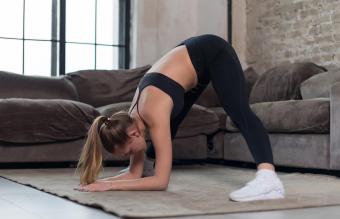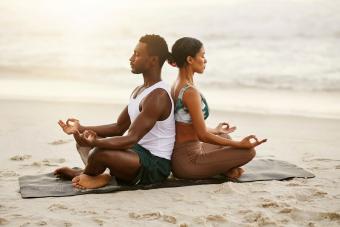
Yoga inversion poses (asanas) are poses in which your heart and hips are above your head. They are an excellent way to improve strength, balance, and flexibility. While they can be challenging to start off with, these beginner inversion poses can help you build the foundation you need to do more advanced inversions.
Standing Forward Bend (Uttanasana)

The standing forward bend, or uttanasana, is a classic yoga pose that can be modified for yogis of all levels. This pose can help stretch and lengthen the spine and legs, soothe anxiety, and reduce tension. It may also help relieve headaches and improve digestion.
Steps to Perform the Pose
- Begin by standing with your feet hip-width apart and your knees slightly bent.
- Inhale and lift your arms up above your head, then exhale and lean forward at the hips as you lower your arms towards the ground.
- Keep your knees bent as you reach your hands towards the ground, trying to touch your toes or shins.
- If you can't reach the ground, don't worry! Place your hands on your shins, on your knees, or on blocks if you have them.
- Relax your head and neck, and let your spine hang heavy. You can also walk your hands to the left or right to stretch out one side of your body at a time.
- Hold the pose for a few breaths, then slowly roll back up to standing, using your hands to support you if needed.
Keep your knees bent if you have tight hamstrings or if it's difficult to reach the ground. Don't worry about touching your toes - just focus on keeping your spine long and relaxed.
Legs Up the Wall (Viparita Karani)
Legs up the wall, or viparita karani, is a gentle inversion pose suitable for beginners. This pose helps improve circulation, reduces stress, and calms the mind. Some people believe this pose may help reduce low back pain and ease headaches.
Steps to Perform the Pose
- Sit on the floor facing a wall, then slowly lower your shoulders and head to the floor, lying on your side.
- Roll over onto your back and stretch your legs up against the wall. Your tailbone should rest on the floor, and your back and head should be aligned on the floor perpendicular to the wall.
- Keep your arms at your sides or resting on your stomach - whichever feels most comfortable.
- Hold this pose for a few minutes, focusing on your breath. To release the pose, slowly lower your legs and return to a seated position.
If you have tight hamstrings, you can place a block or cushion under your hips for added support. You can also use a block or cushion under your head for comfort.
Rabbit (Sasangasana)
The rabbit, or sasangasana, is a yoga inversion pose that stretches the thighs, knees, and ankles, as well as strengthens the back and hips. This pose may help reduce fatigue, improve digestion, and release tension.

Steps to Perform the Pose
- Start on your hands and knees in a tabletop position, with your wrists under your shoulders and your knees under your hips.
- Inhale and lift your hips up and back, bringing your heels towards your buttocks and tucking your toes under.
- Exhale and bring your hands to your lower back, interlacing your fingers and holding onto your heels.
- Inhale and lift your hips up towards the sky, pressing your chest towards your thighs.
- Exhale and tuck your chin towards your chest, bringing the crown of your head towards the ground.
- Hold the pose for several deep breaths, focusing on your breath and allowing your body to relax.
- To release the pose, inhale and lift your hips up, straightening your legs and bringing your arms back by your sides.
If you have tight hips or hamstrings, you can keep your knees bent and place a blanket or block under your hips for support.
Downward Facing Dog (Adho Mukha Svanasana)
Downward facing dog, or adho mukha svanasana, is a classic yoga inversion pose that is foundational to any yoga practice. This pose strengthens the arms, shoulders, and legs, and provides a good stretch for the hamstrings and calves. It can also help improve circulation, reduce stress and fatigue, and relieve headaches.
Steps to Perform the Pose
- Start on all fours with your wrists under your shoulders and your knees under your hips.
- Spread your fingers wide and press your palms firmly into the ground.
- Lift your hips and straighten your legs, creating an inverted V shape with your body.
- Straighten your legs by pressing your heels towards the ground.
- Lower your head between your arms.
- Hold this pose for several breaths before slowly returning to all fours.
If you have wrist or shoulder issues, you can place a rolled-up blanket under your palms to ease pressure. You can also walk your feet closer to your hands to make the pose more manageable.
Dolphin
The dolphin, or ardha pincha mayurasana, is a great alternative to downward dog for those with wrist issues. This yoga inversion pose strengthens and stretches the shoulders, arms, and legs, improves balance, and relieves back pain.
Steps to Perform the Pose
- Begin in a plank position with your hands and feet on the ground, shoulder-width apart.
- Lower onto your forearms and elbows onto the floor, keeping your elbows directly under your shoulders.
- Lift your hips and straighten your legs as much as you can, forming an inverted V shape with your body.
- Gently press your heels into the floor to stretch your calves.
- Relax your head with your eyes gazing back at your knees and hold the pose for a few breaths.
- To release, lower your knees to the ground and return to a plank position.
Place your yoga mat or a block under your forearms for support if you have wrist or elbow pain. If you have difficulty straightening your legs, you can keep your knees bent.
Tripod Headstand Prep (Salamba Sirsasana)

The tripod headstand prep, or salamba sirsasana, is a more intermediate inversion pose that helps improve balance, strengthens the core and upper body, and increases blood flow to the head and brain. This pose is a good way to prepare your mind and body for more advanced inversion poses, like headstands.
Steps to Perform the Pose
- Begin in a downward facing dog pose, with your hands and feet on the ground and your hips lifted.
- Walk your feet closer to your hands and bend your knees, placing the top of your head on the ground.
- Interlace your fingers and place your hands on the ground, about shoulder-width apart.
- Tuck your toes and lift your hips, straightening your legs as much as you can.
- Hold the pose for a few breaths, then lower back down to downward facing dog.
Use a wall for support if you are a beginner or if you have difficulty balancing. Keep your gaze fixed on a spot in front of you to help improve your balance.
Supported Shoulderstand (Salamba Sarvangasana)
The supported shoulderstand, or Salamba Sarvangasana, is an inversion yoga pose that helps to strengthen the shoulders and upper back, reduce tension and anxiety, and promote relaxation.

Steps to Perform the Pose
- Begin by lying on your back with your knees bent and your feet flat on the ground.
- Place a blanket or block under your upper back for support.
- Exhale and lift your legs off the ground, bringing your hips and lower back towards the blanket or block.
- Inhale and lift your hips and upper back off the ground, using your hands to support your lower back.
- Straighten your legs and lift your feet towards the ceiling, keeping your shoulders and upper back on the ground.
- Hold the pose for a few breaths, then exhale and slowly lower your legs and hips back down to the ground.
Use a blanket or block for support if you are a beginner or if you have difficulty lifting your hips and upper back off the ground. Keep your gaze fixed on your toes to help improve your balance.
Give Inversions a Try
Yoga inversion poses are a great way to build strength and flexibility, improve circulation, and help reduce tension in your mind and body. If you are a beginner, these beginner inversion poses can help you build your way up to more advanced inversion poses, such as wheel pose. It is important to listen to your body and stop if you feel any pain. Beginners may find it helpful to consult with an experienced yoga teacher who can help ensure you practice safely. With proper instruction and practice, inversion poses can be a valuable addition to any yoga practice.







